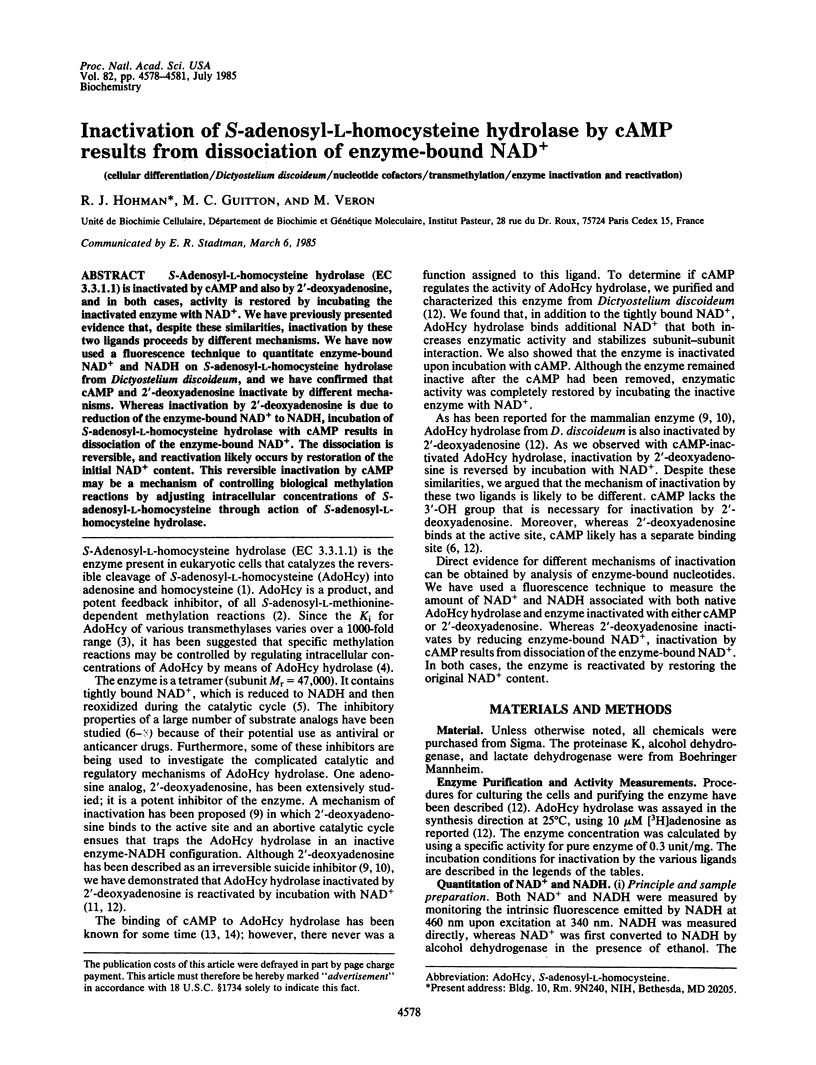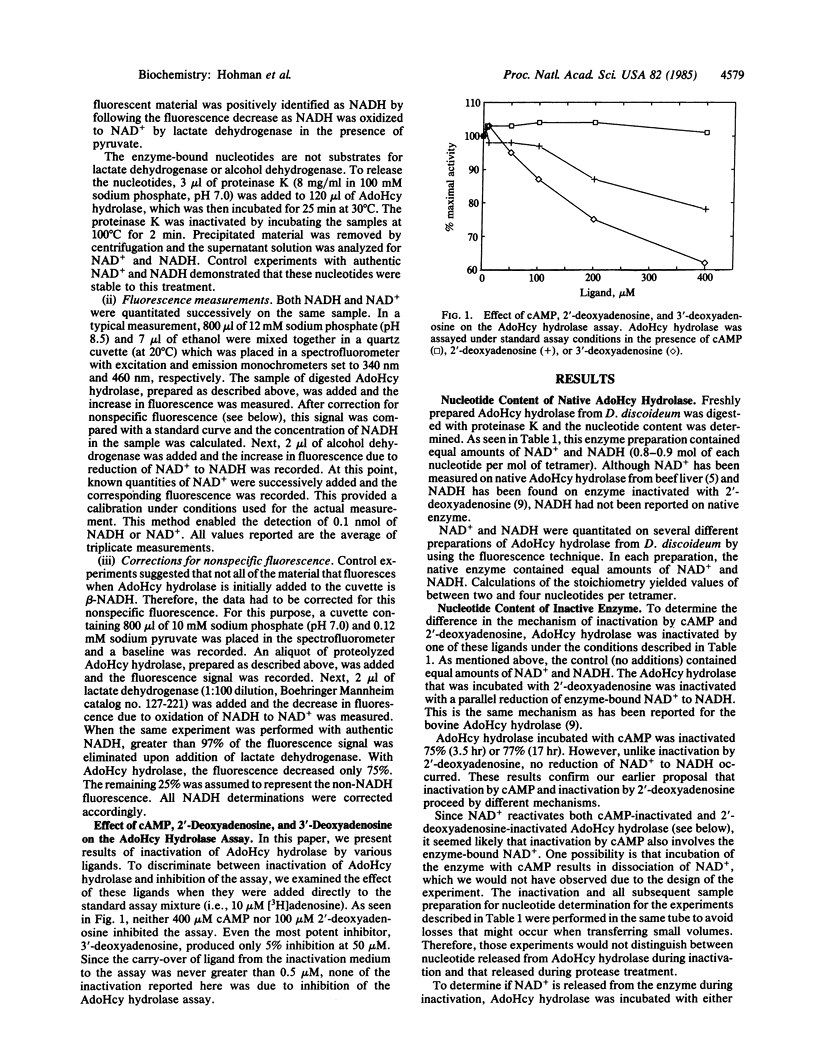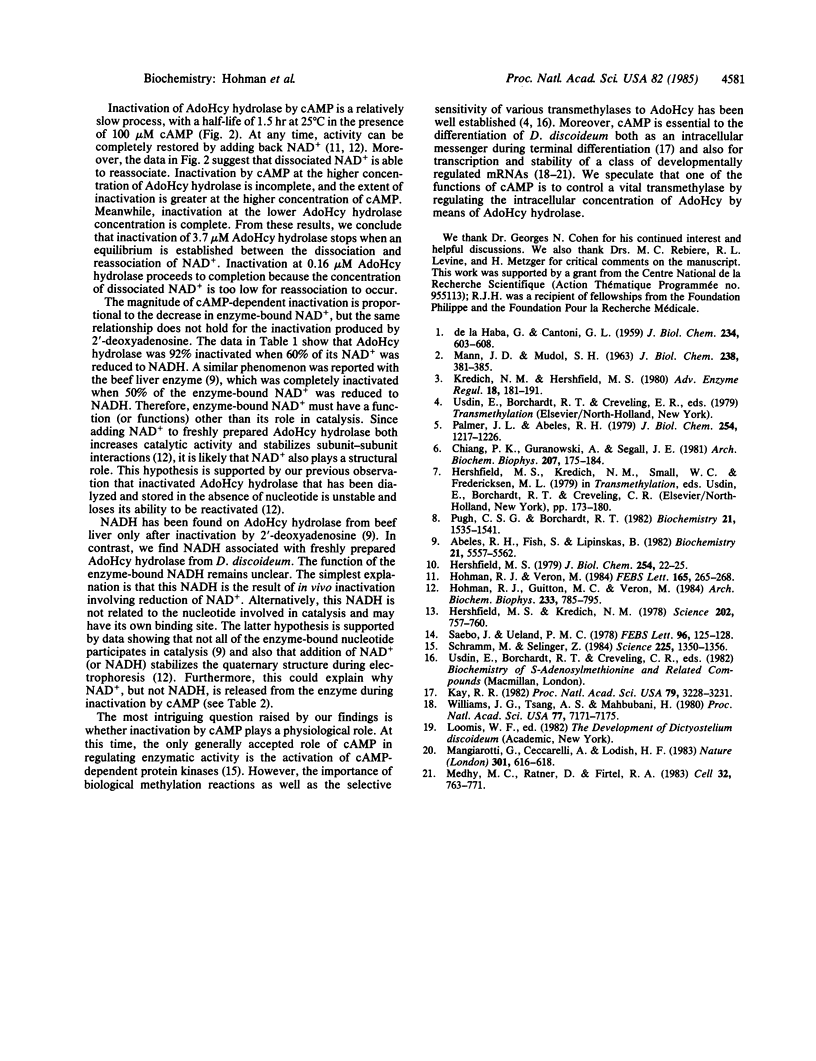Abstract
S-Adenosyl-L-homocysteine hydrolase (EC 3.3.1.1) is inactivated by cAMP and also by 2'-deoxyadenosine, and in both cases, activity is restored by incubating the inactivated enzyme with NAD+. We have previously presented evidence that, despite these similarities, inactivation by these two ligands proceeds by different mechanisms. We have now used a fluorescence technique to quantitate enzyme-bound NAD+ and NADH on S-adenosyl-L-homocysteine hydrolase from Dictyostelium discoideum, and we have confirmed that cAMP and 2'-deoxyadenosine inactivate by different mechanisms. Whereas inactivation by 2'-deoxyadenosine is due to reduction of the enzyme-bound NAD+ to NADH, incubation of S-adenosyl-L-homocysteine hydrolase with cAMP results in dissociation of the enzyme-bound NAD+. The dissociation is reversible, and reactivation likely occurs by restoration of the initial NAD+ content. This reversible inactivation by cAMP may be a mechanism of controlling biological methylation reactions by adjusting intracellular concentrations of S-adenosyl-L-homocysteine through action of S-adenosyl-L-homocysteine hydrolase.
Full text
PDF



Selected References
These references are in PubMed. This may not be the complete list of references from this article.
- Abeles R. H., Fish S., Lapinskas B. S-Adenosylhomocysteinase: mechanism of inactivation by 2'-deoxyadenosine and interaction with other nucleosides. Biochemistry. 1982 Oct 26;21(22):5557–5562. doi: 10.1021/bi00265a027. [DOI] [PubMed] [Google Scholar]
- Chiang P. K., Guranowski A., Segall J. E. Irreversible inhibition of S-adenosylhomocysteine hydrolase by nucleoside analogs. Arch Biochem Biophys. 1981 Mar;207(1):175–184. doi: 10.1016/0003-9861(81)90023-0. [DOI] [PubMed] [Google Scholar]
- DE LA HABA G., CANTONI G. L. The enzymatic synthesis of S-adenosyl-L-homocysteine from adenosine and homocysteine. J Biol Chem. 1959 Mar;234(3):603–608. [PubMed] [Google Scholar]
- Hershfield M. S. Apparent suicide inactivation of human lymphoblast S-adenosylhomocysteine hydrolase by 2'-deoxyadenosine and adenine arabinoside. A basis for direct toxic effects of analogs of adenosine. J Biol Chem. 1979 Jan 10;254(1):22–25. [PubMed] [Google Scholar]
- Hershfield M. S., Krodich N. M. S-adenosylhomocysteine hydrolase is an adenosine-binding protein: a target for adenosine toxicity. Science. 1978 Nov 17;202(4369):757–760. doi: 10.1126/science.715439. [DOI] [PubMed] [Google Scholar]
- Hohman R. J., Guitton M. C., Véron M. Purification of S-adenosyl-L-homocysteine hydrolase from Dictyostelium discoideum: reversible inactivation by cAMP and 2'-deoxyadenosine. Arch Biochem Biophys. 1984 Sep;233(2):785–795. doi: 10.1016/0003-9861(84)90507-1. [DOI] [PubMed] [Google Scholar]
- Hohman R. J., Veron M. S-adenosyl-L-homocysteine hydrolase from Dictyostelium discoideum is inactivated by cAMP and reactivated by NAD+. FEBS Lett. 1984 Jan 9;165(2):265–268. doi: 10.1016/0014-5793(84)80182-9. [DOI] [PubMed] [Google Scholar]
- Kay R. R. cAMP and spore differentiation in Dictyostelium discoideum. Proc Natl Acad Sci U S A. 1982 May;79(10):3228–3231. doi: 10.1073/pnas.79.10.3228. [DOI] [PMC free article] [PubMed] [Google Scholar]
- Kredich N. M., Hershfield M. S. Perturbations in S-adenosylhomocysteine and S-adenosylmethionine metabolism: effects on transmethylation. Adv Enzyme Regul. 1980;18:181–191. doi: 10.1016/0065-2571(80)90015-1. [DOI] [PubMed] [Google Scholar]
- Mangiarotti G., Ceccarelli A., Lodish H. F. Cyclic AMP stabilizes a class of developmentally regulated Dictyostelium discoideum mRNAs. Nature. 1983 Feb 17;301(5901):616–618. doi: 10.1038/301616a0. [DOI] [PubMed] [Google Scholar]
- Mehdy M. C., Ratner D., Firtel R. A. Induction and modulation of cell-type-specific gene expression in Dictyostelium. Cell. 1983 Mar;32(3):763–771. doi: 10.1016/0092-8674(83)90062-4. [DOI] [PubMed] [Google Scholar]
- Palmer J. L., Abeles R. H. The mechanism of action of S-adenosylhomocysteinase. J Biol Chem. 1979 Feb 25;254(4):1217–1226. [PubMed] [Google Scholar]
- Pugh C. S., Borchardt R. T. Effects of S-adenosylhomocysteine analogues on vaccinia viral messenger ribonucleic acid synthesis and methylation. Biochemistry. 1982 Mar 30;21(7):1535–1541. doi: 10.1021/bi00536a011. [DOI] [PubMed] [Google Scholar]
- Saebø J., Ueland P. M. An adenosine 3':5'-monophosphate adenosine-binding protein from mouse liver. Association with S-adenosylhomocysteinase activity. FEBS Lett. 1978 Dec 1;96(1):125–128. doi: 10.1016/0014-5793(78)81076-x. [DOI] [PubMed] [Google Scholar]
- Schramm M., Selinger Z. Message transmission: receptor controlled adenylate cyclase system. Science. 1984 Sep 21;225(4668):1350–1356. doi: 10.1126/science.6147897. [DOI] [PubMed] [Google Scholar]
- Williams J. G., Tsang A. S., Mahbubani H. A change in the rate of transcription of a eukaryotic gene in response to cyclic AMP. Proc Natl Acad Sci U S A. 1980 Dec;77(12):7171–7175. doi: 10.1073/pnas.77.12.7171. [DOI] [PMC free article] [PubMed] [Google Scholar]


